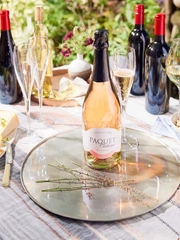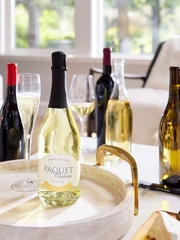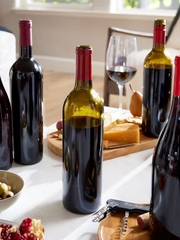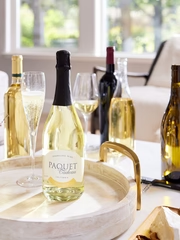 I remember my enology professor, a long time ago, teaching us the art of tasting by using the analogy of “Aladdin, the Genie and the Magic Lamp.” Imagine you are about to be the hero in this famous story. You went through a lot to care for this special bottle of wine. You may not have rubbed it at this point in your life, but you definitely cradled it close to you with care. Now the time has come to get your wishes to come true. Open the cork and let the Genie out of the bottle without spilling any on the carpet. You just released this genie's wine from a small space, where it was possibly confined for several years. Monsieur Cross, my teacher, was pretty unconventional but he made his wine classes fun and I continue to adhere totally to that philosophy today.
Exposing wine to air causes two things:
Oxidation: an example of this process is much like an apple turning brown after its skin is broken.
Evaporation: the physical reaction process of liquid turning into vapor.
Wine is made up of hundreds of compounds, and the process of aeration will enhance the most desirable aromas. It can also help evaporate more undesirable compounds, which typically have weaker vapor tension. There are a few compounds that are reduced with aeration, such as sulfites, which are added to wine to prevent oxidation and microbial activity but can smell like burnt matchsticks, rotten eggs or onion skins.
Ethanol is also a highly volatile compound, and a wine that smells too much like rubbing alcohol when you first open it might lose the ethanol note and become more expressive with some aeration.
I remember my enology professor, a long time ago, teaching us the art of tasting by using the analogy of “Aladdin, the Genie and the Magic Lamp.” Imagine you are about to be the hero in this famous story. You went through a lot to care for this special bottle of wine. You may not have rubbed it at this point in your life, but you definitely cradled it close to you with care. Now the time has come to get your wishes to come true. Open the cork and let the Genie out of the bottle without spilling any on the carpet. You just released this genie's wine from a small space, where it was possibly confined for several years. Monsieur Cross, my teacher, was pretty unconventional but he made his wine classes fun and I continue to adhere totally to that philosophy today.
Exposing wine to air causes two things:
Oxidation: an example of this process is much like an apple turning brown after its skin is broken.
Evaporation: the physical reaction process of liquid turning into vapor.
Wine is made up of hundreds of compounds, and the process of aeration will enhance the most desirable aromas. It can also help evaporate more undesirable compounds, which typically have weaker vapor tension. There are a few compounds that are reduced with aeration, such as sulfites, which are added to wine to prevent oxidation and microbial activity but can smell like burnt matchsticks, rotten eggs or onion skins.
Ethanol is also a highly volatile compound, and a wine that smells too much like rubbing alcohol when you first open it might lose the ethanol note and become more expressive with some aeration.
 After a while, aerated wines begin to oxidize, and the flavors and aromas will flatten out. The denser and more concentrated a wine is, the more it will benefit from aeration, and the longer it can go before beginning to fade.
Our decanting pourer helps to maximize the wine’s contact with oxygen. For this reason, simply popping the cork, and letting it sit, isn’t enough. The oxygen to wine-surface contact is pretty small in the neck of a wine bottle. Swirling in the glass is the simple way to “open up” a wine, but to really get some oxygen in there, the wine may need to be “aerated.”
Handheld aerators like Vinturi or Respirer, for example, expand the surface area of wine, which allows the air to mingle with it. The wine gurgles through the bubbler, out into the glass or decanter, which softens the tannins of young or bold wines. The aerator will easily do the trick in minutes and is appropriate where time is of the essence.
After a while, aerated wines begin to oxidize, and the flavors and aromas will flatten out. The denser and more concentrated a wine is, the more it will benefit from aeration, and the longer it can go before beginning to fade.
Our decanting pourer helps to maximize the wine’s contact with oxygen. For this reason, simply popping the cork, and letting it sit, isn’t enough. The oxygen to wine-surface contact is pretty small in the neck of a wine bottle. Swirling in the glass is the simple way to “open up” a wine, but to really get some oxygen in there, the wine may need to be “aerated.”
Handheld aerators like Vinturi or Respirer, for example, expand the surface area of wine, which allows the air to mingle with it. The wine gurgles through the bubbler, out into the glass or decanter, which softens the tannins of young or bold wines. The aerator will easily do the trick in minutes and is appropriate where time is of the essence.
 Young red wines with tannins such as Cabernet Sauvignon, Zinfandel and Syrah are the best candidates for aeration, but these are not the only ones. If a wine is too cold, an aeration will bring it to room temperature.
As wines age, tannins soften and are balanced by other flavors and a stronger bouquet. But in young red wines, particularly heavy reds, the tannins can be harsh and overwhelming. Aeration won’t increase the complexity of a young wine, like an older wine gains with time in the bottle, but it does soften and smooth out the flavor.
A wine aerator is a rather aggressive approach to opening up a wine, by adding oxygen into the liquid to improve the taste. Decanting performs a somewhat similar act, but the main purpose is to remove the sediment in older wines, leaving it in the bottle, while the wine is poured into a different vessel.
Young red wines with tannins such as Cabernet Sauvignon, Zinfandel and Syrah are the best candidates for aeration, but these are not the only ones. If a wine is too cold, an aeration will bring it to room temperature.
As wines age, tannins soften and are balanced by other flavors and a stronger bouquet. But in young red wines, particularly heavy reds, the tannins can be harsh and overwhelming. Aeration won’t increase the complexity of a young wine, like an older wine gains with time in the bottle, but it does soften and smooth out the flavor.
A wine aerator is a rather aggressive approach to opening up a wine, by adding oxygen into the liquid to improve the taste. Decanting performs a somewhat similar act, but the main purpose is to remove the sediment in older wines, leaving it in the bottle, while the wine is poured into a different vessel.
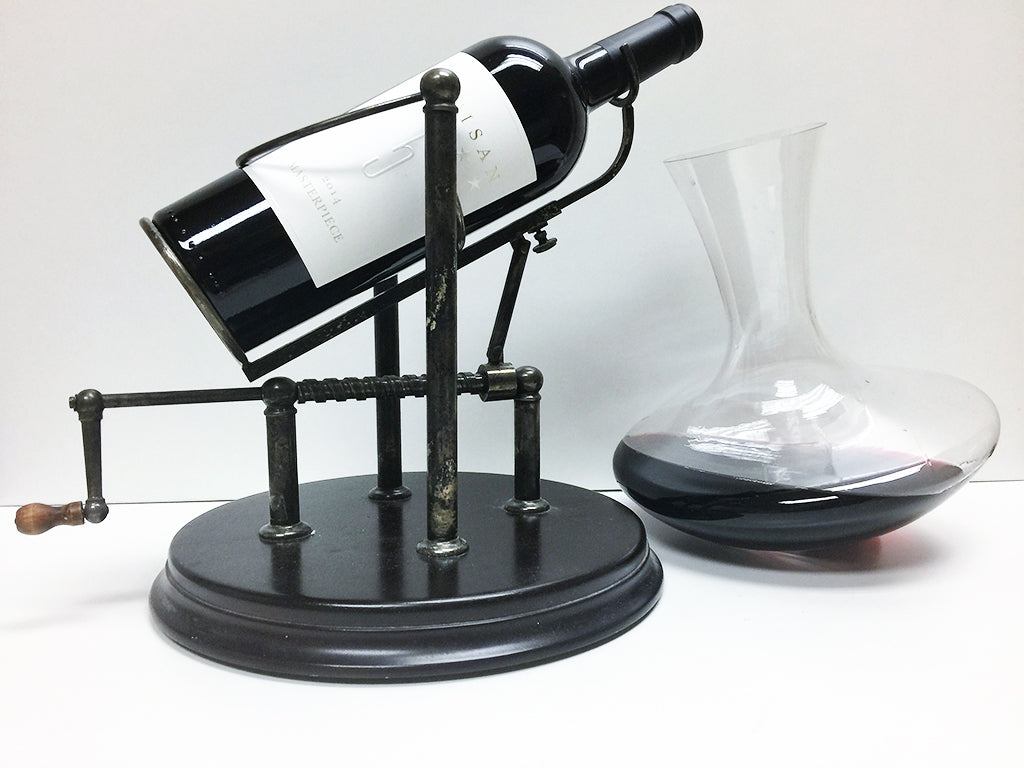 A sommelier, using this Antique Decanter will typically set a light (or candle) under the bottle, and gently pour the wine into a glass vessel (or decanter) until he/she starts to see sediment. The sediment is left in the bottle and the wine in the decanter is then poured into glasses, free of any bitter sediment. Sediment is common in wines of as little as 10 years old, depending on whether they were filtered or fined.
For a dinner party, decanting is a classy way to serve your wine and adds flair to the evening. For younger wines, decant and let sit for a good hour. For older vintages, first taste the wine, right out the bottle, before decanting. By transferring the wine to a decanter, the contact with air will often eliminate any unpleasant odor.
These questions are like fashion, politics, The Voice or seasoning; everybody has an opinion. There are no wrong answers, just a lot of experimenting to find your preferred tasting conditions. Please try several things before making up your mind, but know that new wines and new vintages are coming out all the time. This may change your precedent convictions.
A sommelier, using this Antique Decanter will typically set a light (or candle) under the bottle, and gently pour the wine into a glass vessel (or decanter) until he/she starts to see sediment. The sediment is left in the bottle and the wine in the decanter is then poured into glasses, free of any bitter sediment. Sediment is common in wines of as little as 10 years old, depending on whether they were filtered or fined.
For a dinner party, decanting is a classy way to serve your wine and adds flair to the evening. For younger wines, decant and let sit for a good hour. For older vintages, first taste the wine, right out the bottle, before decanting. By transferring the wine to a decanter, the contact with air will often eliminate any unpleasant odor.
These questions are like fashion, politics, The Voice or seasoning; everybody has an opinion. There are no wrong answers, just a lot of experimenting to find your preferred tasting conditions. Please try several things before making up your mind, but know that new wines and new vintages are coming out all the time. This may change your precedent convictions.


